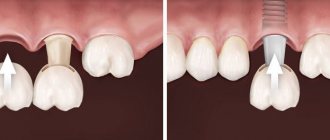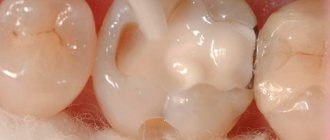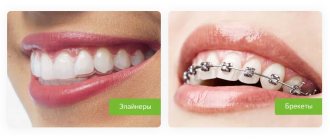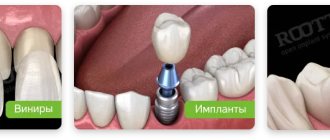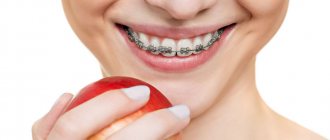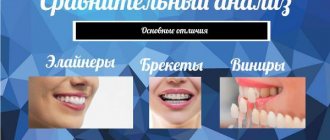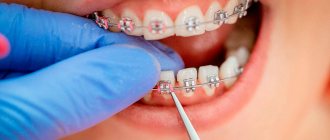Tooth displacement: reasons
The median straight line, which divides the face into two halves, should coincide with the interincisal median lines - that is, with those lines that can be conditionally drawn between the front teeth. All teeth should be symmetrically located relative to this line. If at least one tooth moves away from these lines, this is a malocclusion. In addition, there should be no increased spaces between the teeth; they should not overlap each other in the dentition.
The question of why teeth shift has long been of interest to orthodontists. In the 18th century, the French physician Pierre Fauchard, personal dentist of Louis XV, in his book “The Dentist-Surgeon, or Treatise on the Teeth” (1728), recommended tying abnormally growing teeth with silk threads to a strip of metal. At the end of the 19th century, Edward Engle proposed a classification, diagnostic methods and an apparatus for correcting occlusion, which was sold in American catalogs for about a hundred years - until the 1980s.
As doctors have established, heredity plays a large role in the occurrence of tooth displacement - if one or both parents had bite defects, then there is a high probability that they will appear in their children. In addition to heredity, the following reasons for displacement are distinguished:
- too late eruption of both milk and permanent teeth;
- disruption of the process of replacing baby teeth with permanent ones - for example, very early removal of a baby tooth;
- lack of space in the jaw arches (often leads to crowding of teeth);
- developmental anomalies of one or both jaws;
- abnormalities in tooth size;
- diseases of the temporomandibular joint;
- injuries to teeth and jaws.
In adults, tooth displacement can also occur due to injury or due to tooth loss or extraction. Neighboring teeth begin to shift towards the empty space, forming a malocclusion. This is one of the reasons why dentists, when teeth are lost, strongly recommend restoring them with prosthetics.
Possible consequences
Have you noticed that your front tooth has begun to protrude slightly beyond the row? Do not delay visiting a doctor, as malocclusion is very dangerous. When an incisor or canine is displaced, the following problems are often observed:
- chewing function is impaired,
- the risk of gastrointestinal diseases increases,
- a diastema is formed,
- gum tissue becomes inflamed.
Don't wait for a significant change in the position of the crown - make an appointment with your dentist at the first sign of a problem.
Types of tooth displacement
While everything is quite clear about why teeth shift, many people are confused about the types of this problem. All bite defects are divided into 3 large groups.
- Violation of the position of the teeth: normally there are very narrow spaces between the teeth, and each tooth, except the last in the row, has 2 contact points with its neighbors. If there are enlarged spaces (tremas, diastemas) or teeth are crowded, then this is a defect that needs to be corrected - otherwise it will lead to problems with the gums and increased tooth wear,
- Violation of the development of dentition - they can be either narrowed or expanded.
- Abnormalities affecting the size or position of the jaws. These include:
a) cross bite - the jaws close in a cross direction horizontally, i.e. the teeth overlap;
b) mesial bite - the lower jaw protrudes forward;
c) distal bite - the upper jaw protrudes forward.
If any tooth has changed position as a result of injury or removal of an adjacent tooth, this is also a malocclusion that can be corrected by orthodontists.
What to do if your teeth have moved
Almost all displacements can be corrected, so it is important to promptly seek help from a dentist or orthodontist. The listed pathologies can be treated at any age, but it is better to worry about the problem as early as possible. The less time has passed since the change in the primary occlusion, the more successful the results will be.
At the same time, many experts recommend waiting for the eruption of “eights” or wisdom teeth. Braces, aligners and other orthodontic products often require their removal before treatment, so they most often undergo extraction both after eruption and during the retention stage according to the doctor’s indications.
Correction of the displacement of dental elements can be carried out in the following ways:
- Rotation - the specialist performs available manipulations to rotate the tooth around the central part of its stability.
- Intrusion is the deepening of a protruding element in the jaw row.
- Extrusion is the pulling out of a tooth embedded in the periodontal tissue and located below the remaining bone elements.
- Moving - a tooth is returned to its place if it has moved to the sides, forward or backward. Typically practiced on central line dental units.
- Tilt is a technique that combines rotation with translation.
The listed methods for correcting anomalies are used if there are problems with the maxillofacial apparatus or bite. If the pathological movement is provoked by any diseases, for example, with periodontitis, teeth sometimes shift in adults, it is important to begin treatment by eliminating the identified ailments. Only after this is the bite corrected using orthodontic structures or surgical methods if there are serious indications.
Correction of misaligned teeth
What to do if you see, for example, how the teeth on the lower jaw have shifted?
It seems to many that it is no longer possible to correct the situation in adulthood - the teeth will still return to the wrong position, and besides, correcting the bite is long, difficult and unaesthetic. Fortunately, orthodontists today are successfully correcting misalignments in adult patients. To do this, they use 2 orthodontic systems, which, using the pressure of a calculated force, carefully move the teeth to the correct position.
- Braces
A classic non-removable system that consists of a metal arch, braces - elements that are fixed to each tooth, and locks or ligatures that secure the arch in the braces. Today, these systems have become much more compact and comfortable, and we are no longer talking about long years of correction, since the average treatment period is only 1.5–2 years. Doctors have metal, ceramic, sapphire and combined systems at their disposal. There are also lingual braces - they are fixed on the lingual side of the teeth and are not visible when you smile. - Aligners
A removable system of aligners developed about 3 years ago that are worn on the teeth. For each patient, based on photographs and impressions of the jaws, an individual set of aligners is created, which the patient himself changes according to a schedule drawn up by the orthodontist. Unlike braces, aligners can be removed for 2 hours a day to eat and brush your teeth.
However, in any case, after removing the orthodontic system and completing the bite correction, a period of retention follows - when the patient wears retainers that prevent the teeth from returning to their previous position.
In our Center, we apply the principles of an integrated approach when planning treatment.
For the process to be successful, the patient receives consultation from several specialists. The process involves an orthodontist, an implantologist, and an orthopedist. They draw up a joint treatment plan, taking into account the volume of the bone, the distance between the teeth for the implant and the crown. If you do not take into account these nuances, you will have to re-install braces.
Levin Dmitry Valerievich
Chief physician, Ph.D.
It is important to consider how long ago the tooth was removed:
- If a tooth has been missing for a long time, and the neighboring ones have changed position and left no room for an implant, orthodontic treatment is aimed at freeing up space for an artificial root and crown.
- If implantation is planned after the braces are removed, a spring is placed on the adjacent teeth to prevent them from approaching each other and to leave space for the implant.
- If an implant is already in place and its position interferes with tooth movement, orthodontic treatment becomes more difficult. When trying to move an artificial root, there is a risk of its rejection, the development of inflammation, and tissue injury.
Diastema treatment methods
- Therapeutic method. Suitable only for eliminating small clefts. The essence of the method is the cosmetic restoration of the defect using composite veneers.
- Orthopedic method. Treatment consists of installing ceramic veneers or crowns. This is a fairly effective method that allows you to eliminate diastema for a long period of time.
- Surgical method. It is used if a gap has appeared between the teeth as a result of incorrect positioning of the frenulum of the upper or lower lip. The method is most effective for young patients.
- Orthodontic method. To eliminate the defect, specialized braces, orthodontic aligners, and corrective plates are used. A significant advantage of this method is that the installation of leveling systems does not require grinding or grinding of teeth.
It is important to know. If a diastema is detected on baby teeth, no measures need to be taken to eliminate it! It is necessary to wait until the molars erupt.
The first stage of treatment for tooth transposition
The first step was to move the crown of permanent canine 1.3 into place. Naturally, primary canine 5.3 was removed before installing braces at the stage of sanitation of the oral cavity. For this, a NiTi spring was used to open from the bracket on the second premolar to the canine crown on one side, and light traction with an elastic chain on the other.
Bottom line
Do not panic if your lower tooth has moved forward or backward - in order to avoid complications, it is recommended not to ignore the current situation and consult a doctor. Only an experienced specialist who knows modern diagnostic and therapeutic techniques for solving such problems can develop optimal tactics for restoring a displaced element. In most cases, doctors manage to restore a beautiful smile to patients even with an initially difficult clinical picture.
How to save a loose tooth
Medical tactics depend on the diagnosis. The patient is asked to undergo X-ray diagnostics. This is the best way to study the origins of the problem. From the images, the doctor can determine the degree of destruction of bone tissue and, based on the information received, decide what to do next. If periodontitis is to blame, dental plaque is removed. It is especially important to thoroughly clean the periodontal pockets and interdental spaces. It is best to remove stones using ultrasound. This method is safe and does not cause serious discomfort.
Additionally, the client is prescribed an antibacterial drug. This is necessary to quickly relieve the inflammatory process. If there is significant root destruction, splinting may be required. During the procedure, the dentist drills a small groove on the surface of adjacent teeth and places a miniature fiberglass splint into it. Afterwards, the cavity is closed with a filling compound. This measure makes it possible to securely fix the movable unit and avoid its removal in the coming years. If your teeth are loose due to bruxism - involuntary grinding at night - it is necessary to make a custom night guard. The patient should put it on every time before going to bed. In parallel, he is prescribed a course of vitamin-mineral medications and anticonvulsants. Dentists are asked to pay special attention to oral hygiene. Without it, dental health is impossible. To prevent the accumulation of stone, you need to use dental floss, an irrigator, and special interdental brushes. Moreover, this should be done not from time to time, but daily.
